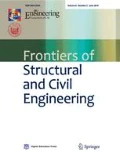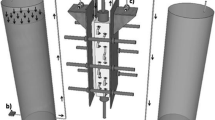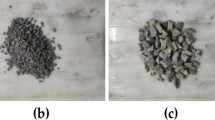Abstract
In this study, sprayable strain-hardening fiber-reinforced cementitious composites (FRCC) were applied to strengthen the concrete slabs in a concrete-face rockfill dam (CFRD) for the first time. Experimental, numerical, and analytical investigations were carried out to understand the flexural properties of FRCC-layered concrete slabs. It was found that the FRCC layer improved the flexural performance of concrete slabs significantly. The cracking and ultimate loads of a concrete slab with an 80 mm FRCC layer were 132% and 69% higher than those of the unstrengthened concrete slab, respectively. At the maximum crack width of 0.2 mm, the deflection of the 80-mm FRCC strengthened concrete slab was 144% higher than that of the unstrengthened concrete slab. In addition, a FE model and a simplified analytical method were developed for the design and analysis of FRCC-layered concrete slabs. Finally, the test result of FRCC leaching solution indicated that the quality of the water surrounding FRCC satisfied the standard for drinking water. The findings of this study indicate that the sprayable strain-hardening FRCC has a good potential for strengthening hydraulic structures such as CFRDs.
Similar content being viewed by others
References
Qu Y, Zou D, Kong X, Liu J, Zhang Y, Yu X. Seismic damage performance of the steel fiber reinforced face slab in the concrete-faced rockfill dam. Soil Dynamics and Earthquake Engineering, 2019, 119: 320–330
Li V C, Leung C K Y. Steady-state and multiple cracking of short random fiber composites. Journal of Engineering Mechanics, 1992, 118(11): 2246–2264
Leung C K Y. Design criteria for pseudoductile fiber-reinforced composites. Journal of Engineering Mechanics, 1996, 122(1): 10–18
Li V C. Engineered Cementitious Composites (ECC)—Bendable Concrete for Sustainable and Resilient Infrastructure. Berlin: Springer-Verlag GmbH Germany, 2019
Huang B T, Yu J, Wu J Q, Dai J G, Leung C K Y. Seawater sea-sand Engineered Cementitious Composites (SS-ECC) for marine and coastal applications. Composites Communications, 2020, 20: 100353
Huang B T, Wu J Q, Yu J, Dai J G, Leung C K Y, Li V C. Seawater sea-sand engineered/strain-hardening cementitious composites (ECC/SHCC): Assessment and modeling of crack characteristics. Cement and Concrete Research, 2021, 140: 106292
Lin X, Yu J, Li H, Lam J Y K, Shih K, Sham I M L, Leung C K Y. Recycling polyethylene terephthalate wastes as short fibers in strain-hardening cementitious composites (SHCC). Journal of Hazardous Materials, 2018, 357: 40–52
Huang B T, Li Q H, Xu S L, Zhang L. Static and fatigue performance of reinforced concrete beam strengthened with strain-hardening fiber-reinforced cementitious composite. Engineering Structures, 2019, 199: 109576
Lorenzoni R, Curosu I, Leonard F, Paciornik S, Mechtcherine V, Silva F A, Bruno G. Combined mechanical and 3D-microstructural analysis of strain-hardening cement-based composites (SHCC) by in-situ X-ray microtomography. Cement and Concrete Research, 2020, 136: 106139
Xu S L, Li Q. Theoretical analysis on bending behavior of functionally graded composite beam crack-controlled by ultrahigh toughness cementitious composites. Science in China Series E: Technological Sciences, 2009, 52(2): 363–378
Huang B T, Li Q H, Xu S L, Zhou B M. Frequency effect on the compressive fatigue behavior of ultrahigh toughness cementitious composites: Experimental study and probabilistic analysis. Journal of Structural Engineering, 2017, 143(8): 04017073
Huang B T, Li Q H, Xu S L, Liu W, Wang H T. Fatigue deformation behavior and fiber failure mechanism of ultra-high toughness cementitious composites in compression. Materials and Design, 2018, 157: 457–468
Wang S, Li V C. Engineered cementitious composites with high-volume fly ash. ACI Materials Journal, 2007, 104(3): 233–241
Zhou J, Pan J, Leung C K Y. Mechanical behavior of fiber-reinforced engineered cementitious composites in uniaxial compression. Journal of Materials in Civil Engineering, 2015, 27(1): 04014111
Huang B T, Li Q H, Xu S L. Fatigue deformation model of plain and fiber-reinforced concrete based on Weibull function. Journal of Structural Engineering, 2019, 145(1): 04018234
Yuan F, Pan J, Xu Z, Leung C K Y. A comparison of engineered cementitious composites versus normal concrete in beam-column joints under reversed cyclic loading. Materials and Structures, 2013, 46(1): 145–159
Qiu J, Yang E H. Micromechanics-based investigation of fatigue deterioration of engineered cementitious composite (ECC). Cement and Concrete Research, 2017, 95: 65–74
Huang B T, Weng K F, Zhu J X, Xiang Y, Dai J G, Li V C. Engineered/strain-hardening cementitious composites (ECC/SHCC) with an ultra-high compressive strength over 210 MPa. Composites Communications, 2021, 26: 100775
Curosu I, Mechtcherine V, Forni D, Cadoni E. Performance of various strain-hardening cement-based composites (SHCC) subject to uniaxial impact tensile loading. Cement and Concrete Research, 2017, 102: 16–28
Huang B T, Li Q H, Xu S L, Zhou B M. Tensile fatigue behavior of fiber-reinforced cementitious material with high ductility: Experimental study and novel P-S-N model. Construction and Building Materials, 2018, 178: 349–359
Yang Y, Lepech M D, Yang E H, Li V C. Autogenous healing of engineered cementitious composites under wet-dry cycles. Cement and Concrete Research, 2009, 39(5): 382–390
Li M, Li V C. Cracking and healing of engineered cementitious composites under chloride environment. ACI Materials Journal, 2011, 108(3): 333–340
Liu H, Zhang Q, Gu C, Su H, Li V. Self-healing of microcracks in engineered cementitious composites under sulfate and chloride environment. Construction and Building Materials, 2017, 153: 948–956
Şahmaran M, Li V C. Durability of mechanically loaded engineered cementitious composites under highly alkaline environments. Cement and Concrete Composites, 2008, 30(2): 72–81
Wu H L, Du Y J, Yu J, Yang Y L, Li V C. Hydraulic conductivity and self-healing performance of engineered cementitious composites exposed to acid mine drainage. Science of the Total Environment, 2020, 716: 137095
Kunieda M, Rokugo K. Recent progress on HPFRCC in Japan. Journal of Advanced Concrete Technology, 2006, 4(1): 19–33
Kim Y Y, Kong H J, Li V C. Design of engineered cementitious composite suitable for wet-mixture shotcreting. Materials Journal, 2003, 100(6): 511–518
Kanda T, Saito T, Sakata N, Hiraishi M. Tensile and anti-spalling properties of direct sprayed ECC. Journal of Advanced Concrete Technology, 2003, 1(3): 269–282
Rokugo K, Kanda T, Yokota H, Sakata N. Applications and recommendations of high performance fiber reinforced cement composites with multiple fine cracking (HPFRCC) in Japan. Materials and Structures, 2009, 42(9): 1197–1208
Zhang Q, Li V C. Development of durable spray-applied fire-resistive Engineered Cementitious Composites (SFR-ECC). Cement and Concrete Composites, 2015, 60: 10–16
Huang B T, Li Q H, Xu S L, Zhou B. Strengthening of reinforced concrete structure using sprayable fiber-reinforced cementitious composites with high ductility. Composite Structures, 2019, 220: 940–952
China National Standardization Management Committee. Common Portland Cement: GB 175–2007. Beijing: Standards Press of China, 2007 (in Chinese)
Ministry of Housing and Urban-Rural Development of the People’s Republic of China. Standard for Test Methods of Concrete Physical and Mechanicals Properties: GB/T 50081–2019. Beijing: China Architecture & Building Press, 2019 (in Chinese)
ISO. Testing of concrete—Part 3: Making and curing test specimens: ISO 1920–3: 2019. Geneva: International Organization for Standardization, 2019
Ministry of Health of the People’s Republic of China. Standard Examination Methods for Drinking Water-Organic Parameters: GB/T 5750.8–2006. Beijing: Standards Press of China, 2006 (in Chinese)
Ministry of Water Resources of the People’s Republic of China. Design Code for Concrete Face Rockfill Dams: SL 228–2013. Beijing: China Water & Power Press, 2013 (in Chinese)
Huang B T, Li Q H, Xu S L, Li C F. Development of reinforced ultra-high toughness cementitious composite permanent formwork: Experimental study and digital image correlation analysis. Composite Structures, 2017, 180: 892–903
Huang B T, Dai J G, Weng K F, Zhu J X, Shah S P. Flexural performance of UHPC-concrete-ECC composite member reinforced with perforated steel plates. Journal of Structural Engineering, 2021, 147(6): 04021065
ASTM. Standard Practice for Making and Curing Concrete Test Specimens in the Field: ASTM C31/C31M-19. West Conshohocken: ASTM International, 2019
Mahabad N M, Imam R, Javanmardi Y, Jalali H. Three-dimensional analysis of a concrete-face rockfill dam. Proceedings of the Institution of Civil Engineers-Geotechnical Engineering, 2014, 167(4): 323–343
Xu L Y, Huang B T, Dai J G. Development of engineered cementitious composites (ECC) using artificial fine aggregates. Construction & Building Materials, 2021, 305: 124742
Li Q H, Yin X, Huang B T, Luo A M, Lyu Y, Sun C J, Xu S L. Shear interfacial fracture of strain-hardening fiber-reinforced cementitious composites and concrete: A novel approach. Engineering Fracture Mechanics, 2021, 253: 107849
Ministry of Water Resources of the People’s Republic of China. Specification for Evaluating Durability of Hydraulic Concrete Structures: SL 775–2018. Beijing: China Water & Power Press, 2018 (in Chinese)
Ministry of Housing and Urban-Rural Development of the People’s Republic of China. Standard for Design of Concrete Structure Durability: GB/T 50476–2019. Beijing: China Architecture & Building Press, 2019 (in Chinese)
Paul S C, van Zijl G P A G. Mechanically induced cracking behaviour in fine and coarse sand strain hardening cement based composites (SHCC) at different load levels. Journal of Advanced Concrete Technology, 2013, 11(11): 301–311
Paul S C, van Zijl G P A G. Crack formation and chloride induced corrosion in reinforced strain hardening cement-based composite (R/SHCC). Journal of Advanced Concrete Technology, 2014, 12(9): 340–351
Dassault Systèmes. ABAQUS Analysis User’s Guide. Providence: Dassault Systèmes Simulia Corp., 2016
Li H, Xu S. Determination of energy consumption in the fracture plane of ultra high toughness cementitious composite with direct tension test. Engineering Fracture Mechanics, 2011, 78(9): 1895–1905
Yu J, Lu C, Chen Y, Leung C K Y. Experimental determination of crack-bridging constitutive relations of hybrid-fiber strain-hardening cementitious composites using digital image processing. Construction and Building Materials, 2018, 173: 359–367
Genikomsou A S, Polak M A. Finite element analysis of punching shear of concrete slabs using damaged plasticity model in ABAQUS. Engineering Structures, 2015, 98: 38–48
International Federation for Structural Concrete (fib). fib Model Code for Concrete Structures 2010. Lausanne: International Federation for Structural Concrete (fib), 2013
Huang J Q, Dai J G. Flexural performance of precast geopolymer concrete sandwich panel enabled by FRP connector. Composite Structures, 2020, 248: 112563
Kabir M I, Lee C K, Rana M M, Zhang Y X. Flexural and bondslip behaviours of engineered cementitious composites encased steel composite beams. Journal of Constructional Steel Research, 2019, 157: 229–244
Xu S, Mu F, Wang J, Li W. Experimental study on the interfacial bonding behaviors between sprayed UHTCC and concrete substrate. Construction and Building Materials, 2019, 195: 638–649
Li Q H, Yin X, Huang B T, Luo A M, Lyu Y, Sun C J, Xu S L. Shear interfacial fracture of strain-hardening fiber-reinforced cementitious composites and concrete: A novel approach. Engineering Fracture Mechanics, 2021, 253: 107849
Huang J Q, Dai J G. Direct shear tests of glass fiber reinforced polymer connectors for use in precast concrete sandwich panels. Composite Structures, 2019, 207: 136–147
Khan M K I, Lee C K, Zhang Y X. Numerical modelling of engineered cementitious composites-concrete encased steel composite columns. Journal of Constructional Steel Research, 2020, 170: 106082
Othman H, Marzouk H. Finite-element analysis of reinforced concrete plates subjected to repeated impact loads. Journal of Structural Engineering, 2017, 143(9): 04017120
Xu L Y, Huang B T, Li V C, Dai J G. High-strength high-ductility Engineered/Strain-Hardening Cementitious Composites (ECC/SHCC) incorporating geopolymer fine aggregates. Cement and Concrete Composites, 2022, 125: 104296
Xu S L, Xu H L, Huang B T, Li Q H, Yu K Q, Yu J T. Development of ultrahigh-strength ultrahigh-toughness cementitious composites (UHS-UHTCC) using polyethylene and steel fibers. Composites Communications, 2022, 29: 100992
Acknowledgements
This study was financially supported by the National Natural Science Foundation of China (Grant Nos. 51978607 and 51878601). The authors would like to thank Mr. Xiao-Hua Ji and Dr. Fu-Jiang Mu at Zhejiang University for their support in the experiments.
Author information
Authors and Affiliations
Corresponding author
Rights and permissions
About this article
Cite this article
Li, Q., Yin, X., Huang, B. et al. Strengthening of the concrete face slabs of dams using sprayable strain-hardening fiber-reinforced cementitious composites. Front. Struct. Civ. Eng. 16, 145–160 (2022). https://doi.org/10.1007/s11709-022-0806-4
Received:
Accepted:
Published:
Issue Date:
DOI: https://doi.org/10.1007/s11709-022-0806-4




